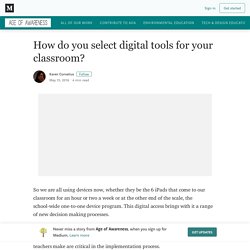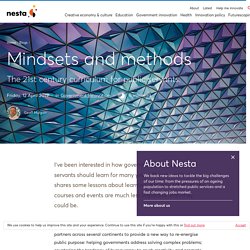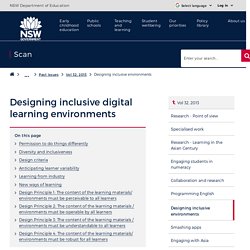

Eli3035. How To Create a Personal Learning Environment to Stay Relevant in 2013. “Our understanding of learning has expanded at a rate that has far outpaced our conceptions of teaching. A growing appreciation for the porous boundaries between the classroom and life experience…has created not only promising changes but also disruptive moments in teaching.” EDUCAUSE Review, 2012. Enhancing learning and teaching through the use of digital technology - gov.scot. The Seven Spaces of Technology in School Environments. How do you select digital tools for your classroom?
So we are all using devices now, whether they be the 6 iPads that come to our classroom for an hour or two a week or at the other end of the scale, the school-wide one-to-one device program.

This digital access brings with it a range of new decision making processes. Research is quite clear, and has been for a while; if this digital access is bring about improved learning outcomes and greater student engagement, the decisions teachers make are critical in the implementation process. The use of ICT tools and resources in modern education is of paramount importance, regardless of the subject or topic being taught. The information era has forced educators to effectively implement ICT tools and resources in their teaching practice in order to successfully prepare students for the knowledge economy (Maier & Warren 2000, pp.4). There are several key aspects to assess when determining the usability and effectiveness of ICT resources in a primary classroom.
Next Generation Digital Learning Environment in LEADing Lights. How has LEADing Lights provided a Digital Learning Environment? LEADing Lights integrates purpose-built cloud-based learning tools in Office 365, Dynamics 365, Power BI, and the Claned content sharing system to serve individual student learning and an adaptive state-wide education system (Goss, 2017). Examples of the capabilities of our digital learning environment include: NGDLE Components and the LEADing Lights platform. Mindsets and methods. I’ve been interested in how governments and public servants should learn for many years.

This short blog shares some lessons about learning, and why I think many courses and events are much less impactful than they could be. The prompt is that Nesta recently launched States of Change with partners across several continents to provide a new way to re-energise public purpose: helping governments address solving complex problems; countering the tendency of bureaucracy to crush creativity and promote cynicism; and leaving behind public agencies that are high energy and restless in finding ways to do better. Led by Brenton Caffin, States of Change brings together a faculty with a huge amount of practical experience across the world. My own experience includes jobs in local, national and European government and doing hundreds of lectures and workshops at places like the UK’s Civil Service College, ANZSOG, the China Executive Leadership Academy and the European Union School of Administration.
Culture and effective online learning environments. Figure A 1 from the original version of ‘Teaching at a Distance’ Over the last two months I have done a couple of workshops on building an effective learning environment, based on Appendix 1 of my online, open textbook, Teaching in a Digital Age.

I identified the following as critical components of an effective learning environment: learner characteristicscontentskillslearner supportresourcesassessment These workshops have reinforced my feeling that I originally excluded a critical component. How are our students using digital tools for learning? – Learning Technologies. Digital Learning Environments: A multidisciplinary focus on 21st cent… Designing inclusive digital learning environments. The goal of education in the 21st century is not simply the mastery of content knowledge or use of new technologies.

It is the mastery of the learning process. Education should help turn novice learners into expert learners—individuals who want to learn, who know how to learn strategically, and who, in their own highly individual and flexible ways, are well prepared for a lifetime of learning. CAST, 2011, p. 4 Introduction Every school in Australia has legal obligations and responsibilities under Federal legislation such as the Disability Standards for Education (2005) to ensure that all learners with or without a disability are able to participate in learning on the same basis.
Since the implementation of the Disability Discrimination Act (1992) and the Disability Standards for Education (2005), the shape of what constitutes a modern classroom has changed and continues to evolve. Permission to do things differently Diversity and inclusiveness Equitable use. Design criteria CAST, 2011 p. 4. 'This is the fourth industrial revolution – we need a new curriculum for tomorrow's world'
In my last Tes blog, I argued that we need to engage in a serious, fundamental debate about the education system.

I wrote that if we are to prepare our children and young people for the world they will live and work in, then we must ditch the false divide between knowledge and skills. We must acknowledge that we need both. And I noted that the Organisation for Economic Cooperation and Development is strongly advocating curricula that integrate knowledge, across subject disciplines, with skills development. Andreas Schleicher, the head of education at the OECD, looks ahead to the abilities that will increasingly be needed by our school leavers in the future. He argues that the demands on learners and on education systems are evolving quickly. Schleicher says that, in the past, education was primarily about teaching people something.
Measures of change. The N2GDLE Vision: The “Next” Next Generation Digital Learning Environment. What is the Next Generation of Digital Learning Environments? As technology continues to evolve, educators and those in Edtech are looking for ways to improve technology to match the needs of teachers and students. Digital Identity - SLIDE: Student Learning in a Digital Environment - LibGuides at Edith Cowan University. Next Generation Digital Learning Environments (NGDLE) The next generation digital learning environment (NGDLE) is a key influencer for the University of Minnesota when considering appropriate paths towards the future of higher education.

The NGDLE is a framework outlined in a research report by EDUCAUSE. The report describes how the future will focus on creating an environment or ecosystem of interconnected learning tools built on common standards. The ecosystem would then enable colleges, departments, and instructors to select tools that customize and extend the LMS to meet their unique teaching and learning needs.
What does an NGDLE look like? EDUCAUSE relates it to Lego bricks, or a “toolbox of applications, content and platforms that could be assembled in custom ways” based on how the individual or institution wants to build it. Digital Learning Environments: A multidisciplinary focus on 21st cent… Next Generation Digital Learning Environment in LEADing Lights.